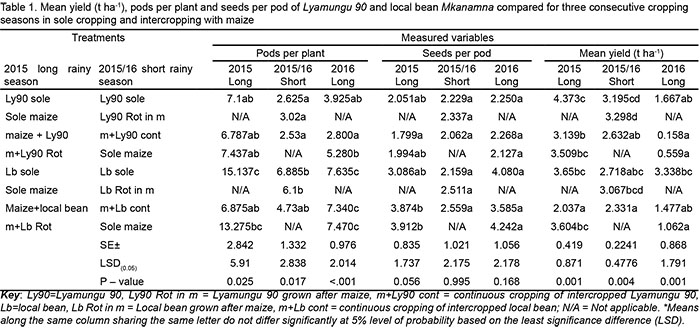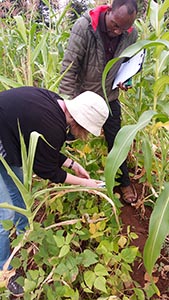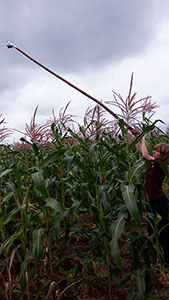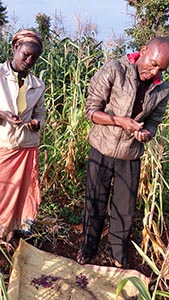The aim of my study is to unravel the contributions of genetic, environmental and management related factors to common bean yield and nitrogen fixation. I am conducting a continuous cropping study, which involves rotations and intercropping of common bean with maize for six seasons and compare the performance of two bean varieties; namely improved Lyamungu 90 and local Mkanamna.
After three consecutive cropping seasons, long–short–long seasons, for 2015–2015/2016–2016 mean bean yield (t ha-1), number of pods per plant and number of seeds per pod were compared (Table 1). The mean number of pods per plant and seeds per pod indicated that local bean Mkanamna outperformed Lyamungu 90. This could be attributed to the differences in their genotypes and formation of many branches in local bean.

The yield of Lyamungu 90 significantly (P <0.05) outperformed yield of local bean Mkanamna during the first and second cropping season. Under sole cropping during the 2015 long and short rainy seasons, the mean yield of Lyamungu 90 was 4.373 t ha-1 and 3.195 t ha-1. Those of local bean Mkanamna were lower, 3.650 t ha-1, 2.718 t ha-1, respectively. Mean yield dropped to 1.667 t ha-1 for Lyamungu 90 and decreased to 3.338 t ha-1 for local bean Mkanamna during the 2016 long rainy season, as compared to the 2015 long rainy season. Intercropping of maize with beans resulted in a higher Lyamungu 90 yield. The yield of Lyamungu 90 was 3.139 t ha-1 and 2.632 t ha-1 and the mean yield of local bean Mkanamna was 2.037 t ha-1 and 2.331 t ha-1 during the 2015 long and short rainy seasons. Under rotations of sole maize with pure beans, the yield of Lyamungu 90 (3.298 t ha-1) was superior to those of local bean (3.067 t ha-1) for the measurements taken during the 2015 short rainy season. When intercrops of beans and maize were grown continuously, the yields of Lyamungu 90 were 3.139 t ha-1, 2.632 t ha-1 and 0.158 t ha-1, while those of local bean Mkanamna were 2.037 t ha-1, 2.331 t ha-1, and 1.477 t ha-1 for the three cropping seasons. In rotating intercrops of maize and beans with sole maize, the data taken during the 2015 and 2016 long rainy seasons indicated that the yields of local bean Mkanamna were 3.604 t ha-1 and 1.062 t ha-1. These were superior to yields of Lyamungu 90 recorded during similar cropping seasons, which were 3.509 t ha-1 and 0.559 t ha-1, respectively.
However, Lyamungu 90 yield declined significantly (P =0.001) during the 2016 long rainy season, during which local bean Mkanamna outperformed Lyamungu 90. The reasons for these are not yet clear, but it could be that Lyamungu 90 yields better, when rain is adequate. Furthermore, there was extended drought during 2015/2016 cropping season, hence entirely irrigation was used. Delayed rains, heavy short-time rains, drought with shortage of irrigation water, and ability of local bean Mkanamna plants to delay flowering, hence avoidance of flower abortion, were also observed. On the other hand, there was substantial lodging of Lyamungu 90 plants compared with local bean Mkanamna plants.
 |
 |
 |
 |
|
Eva Thuijsman, MSc student Wageningen University, assisting Eliakira Kisetu in measuring chlorophyll content in the experimental plots using SPAD in Hai district, Tanzania |
Eva Thuijsman holding a camera supported at the top with a rod for easy taking photos on ground coverage in the experimental plots in Hai district, Tanzania |
Eva Thuijsman taking data on light interception using a light meter in the experimental plots in Hai district, Tanzania |
Gladness Pius Lema, a trained casual labour, assisting Eliakira Kisetu in counting bean grains at harvest in Hai district, Tanzania |
Measurements related to the amount of light intercepted, chlorophyll content, plant height and ground coverage were taken (Picture 1). The results of these measurements will be used to explain the observed differences in performance of beans and maize in mono-cropping and intercropping.
Eliakira Kisetu Nassary, Wageningen University, The Netherlands (See here for his 2015 update)
